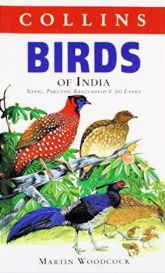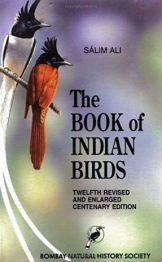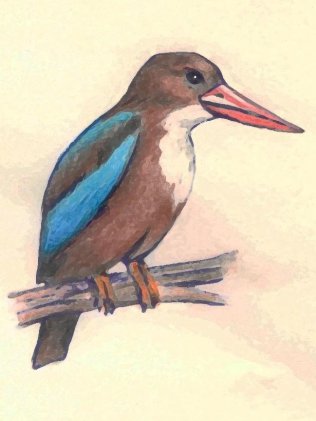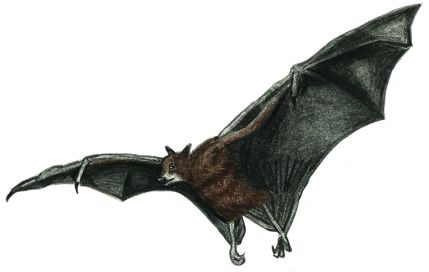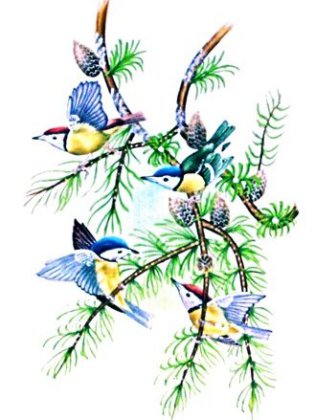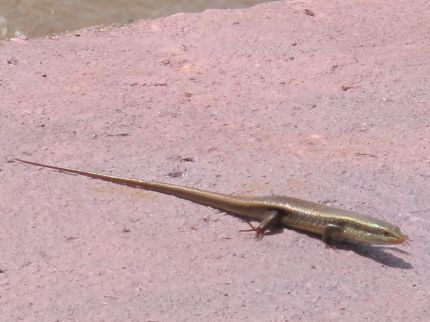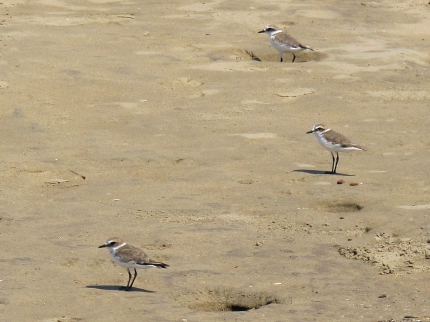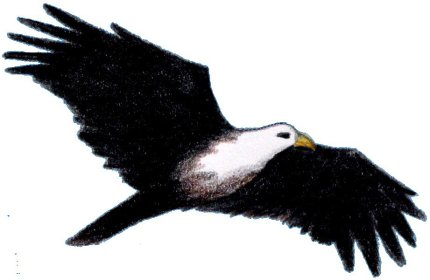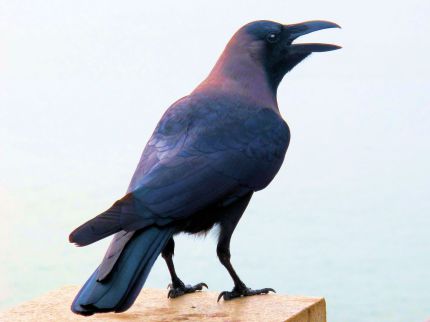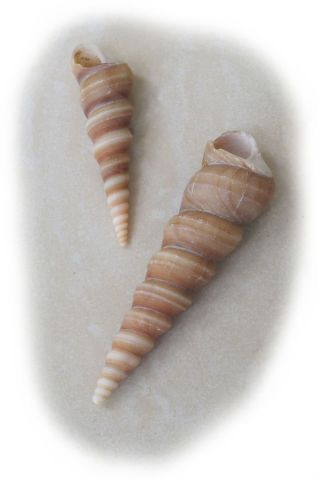
Wildlife
In the first few days at my girlfriend’s apartment I kept seeing birds flying around the area but I was frustrated as I had forgotten to pack my Indian bird book from England.
It took several days before I was able to buy any books. I bought two from the Mandovi Hotel. The Collins Birds of India by Martin Woodcock and The Book of Indian Birds by Sálim Ali.
The first book is a small paperback covering main species while the other is a large hardback covering every species in India. The two books complement each other perfectly; the first as a quick reference while the other giving a greater detail on a huge range of species.
Martin Woodcock has been painting wildlife for over forty years, specialising in birds. He has illustrated over twenty field guides and monographs and his work is in many private collections.
Dr Sálim Ali, born 12 November 1896, was a highly respected Indian ornithologist and naturalist. In his life he conducted many surveys of wildlife in India. He wrote several bird books that popularised ornithology in India. Several species of birds, a couple of bird sanctuaries and institutions have been named after him. He died on 20 June 1987.
The books made all the difference and I was quickly able to identify several species of birds that flew near the apartment. On one occasion I went for a short walk across the paddy fields to the east. I saw baya weaver, paddybird which is a kind of heron, and a cormorant.
My camera is a very good compact zoom camera suitable for tourism but not so suitable for wildlife photography. I thought I would try drawing some of the wildlife that I was seeing. So Sweetness took me to Panaji so I could buy some art materials. I bought a drawing pad, a pack of 12 colour pencils, a pencil sharpener, a 12” ruler and a pen for 100 rupees or about £1·40.
Incredible value but the poor quality showed. The pencils were very soft and it was impossible to maintain a point and it shows I my impression of the white-breasted kingfisher.
In England I have a customised kit of Derwent pencils costing £1·20 each. Compare the kingfisher to the other drawings on this page which I drew using this kit in England.
White-breasted kingfishers and European kingfishers were frequently flying low across the wet paddy fields around the apartment block.
Bats!
In the evening of Wednesday 15 September, Sweetness and I sat on the north balcony for some time. She was sorting some papers out and I finished my work and watched the wildlife. I watched what I thought were some kind of bird of prey. They were much bigger than crows, had a slow wing beat and flew straight and true. But there was something else about them. I looked more intently. They were bats! Huge bats and there were lots of them.
I pointed them out to Sweetness and she said she’d never seen them before.
‘You mean to say that you’ve lived here all your life and you never noticed these huge bats before!?! I said incredulously.
‘Yes,’ she rplied.
Fruit bat Pteropus giganteus
The second half of the scientific name is completely apt. They are huge! As big as hawks. On the evening of Sunday 10 October, we went to Miramar Beach and walked to the sea then we sat on a bench and saw the huge bats hanging in the tree next to us, just three or four feet above us. I created this drawing in England after the expedition.
Pitch-pitchi
A year or so ago Sweetness came to England and brought a picture of two pairs of birds that she called pitch-pitchi. ‘I used to watch them with my grandfather when I was kid’ she said in wistful remembrance.
As I’m interested in wildlife and birdlife in particular I tried to research these birds for this last year. I went through various books and search engines on the internet. I tried every variation of spelling that I could think of and quizzed Sweetness on the spelling whenever we spoke. Even earlier this expedition I asked her if pitch-pitchi was a real name or just one that her grandfather made up. ‘Yes, I think he did make it up’ was her reply.
Now what can I do?
I remember this now because after breakfast I actually saw a pitch-pitchi! There were a few small birds outside the west balcony and I trained my binoculars on one. It was generally green with a greyish head, rusty cap and light underparts; its long tail was erect like a wren. Not really much like the picture gift from Sweetness. I checked in both of my bird books and found it to be a tailorbird. In the Om Field Guide Birds of India, the call of the common tailorbird is described as pitchik-pitchik-pitchik... and with great relief the mystery was solved
Summary of wildlife
This is a summary of the wildlife that I observed during my expedition to Goa, the vast majority of which I had obviously never seen before. My new books were essential in identifying the birdlife, I used the internet for the other species.
Seashore
-
Jellyfish – washed up on shore of Miramar beach, species unidentified.
-
Sand Bubbler Crab of genera Scopimera and Dotilla – billions in excavations along Miramar Beach high and low tide area.
Insects
-
Cockroach – At least one or two come into the house every day. They fall out of the coconut palms and can’t seem to find their way out.
-
Mosquito – We are always wary and close all doors and windows before sundown. They bite me but not Sweetness or Rod
-
Fruit-sucking Moth – Resting on a landing window in the apartment block.
Fruit-sucking Moth
Reptiles
-
House Gecko – Green colour, one behind the clock above Emily’s bedroom door.
-
Goan Day Gecko Cnemaspis Goaensis – This is a bit of a guess. A gecko appeared on the parapet of Sea Pebbles restaurant by the sea. The eyesight of geckos is generally poor and, like snakes, they taste smell with their tongues. I kept downwind of it and was able to get within just a few feet of it. I estimated it to be about 10 inches long. I disturbed a lizard or a gecko, also perhaps ten inches long. It shot away from my feet in the untidy grass and made me jump.
-
Water Snake – Below wall at the Spice Plantation.
Goan Day Gecko Cnemaspis Goaensis
The species is a bit of a guess.
Birds connected with water
-
Little Cormorant Phalacrocorax Niger – These are often seen on low perches in the paddy fields and other lakes and ponds.
-
Darter or Snakebird Anhinga Rufa – Seen at Carambolim Lake flying and also swimming with their bodies submerged.
-
Great Egret Casmerodius Albus – These are quite common in paddy fields.
-
Purple Heron Ardea Purpurea – Seen flying and at rest at Carambolim Lake. This species is also native to Europe and occasionally seen in Britain.
-
Paddybird (Egret) Ardeola Grayii – This is the most often seen of the heron/egret family in India. They have confusing plumage as they look generally brown at rest but their wings are white in flight.
-
Little Green Heron Butorides Striatus – I saw one at the side of a road on Divar Island.
-
Bar-headed Goose Anser Indicus –
-
Whistling Duck Dendrocygna Javanica – Half a dozen or so frequent the paddy field to the east of the apartment complex.
-
Kentish Plover Charadrius Dubius – A few seen along the beach.
-
White-breasted Waterhen – Near the end of the expedition in the paddy fields around the apartment.
-
Red-wattled Lapwing – A couple were seen to the east of the apartment.
-
Whimbrel Nimenius Phaeopus– Sweetness and I saw a pair on Miramar Beach.
Kentish Plover Charadrius Dubius on Miramar Beach
Birds of Prey
-
Brahminy Kite Haliastur Indus – The most prolific of the two kites, they are seen everywhere, every day. Brahminys are smaller, but bulkier and more like a hawk than Pariahs. They have a white head and front body, dark elsewhere. Hawk tail not forked.
-
Pariah Kite Milvus Migrans – These are dark all over, with forked/triangular tail and physically similar to Red Kite. I first saw these at Mumbai Airport but I couldn’t identify them at the time.
Brahminy kite Haliastur indus
Drawing created by me in England.
Medium-sized birds
-
Rose-ringed Parakeet Psittacula Krameri – Known as ring-necked parakeet in England. These come to the palm trees around the apartment every day.
-
Plum-headed Parakeet Psittacula Cyanocephala – Male has plum and blue head with green elsewhere, female as greyish head.
-
Greater Coucal Centropus sinensis – Seen in the compound near to generator.
-
White-breasted Kingfisher Halcyon Smyrnensis – These have an iridescent blue back, brown front with white bib. I often see one from the apartment.
-
Kingfisher Alcedo atthis – European variety, flies all around paddy fields.
-
Little Green Bee-eater Merops Orientalis – A few in the trees or on telephone lines around the paddy fields.
-
Grey Hornbill Tockus Birostris – One seen at Carambolim Lake.
-
Black-rumped Flameback Woodpecker Dinopium Benghalese – Crested red crown, black and white body with golden brown back.
Rose-ringed Parakeet Psittacula Krameri
I drew this ring-necked parakeet in England. It turns out that these are the same species, psittacula krameri. This is an example of where the scientific classification can be useful.
Song Birds
-
Red-whiskered Bulbul Pycnonotus Cafer – Seen around the apartment block.
-
Tailorbird Othotomus sutorius – call is ‘Pitch-pitchi’.
-
Black Drongo Dicrurus Adsimilis – Dark all over with a Y-shaped tail
-
House Crow Corvus Splendens – Like small hooded crow. Very used to humans. One near the apartment croaks ‘Goa! Goa! Goa!’ Sometimes seen mobbing kites.
House Crow Corvus Splendens
-
House Swifts Apus Affinis – Dark all over except for white rump. At a glance they look and behave a lot like house martins in Britain.
-
Jungle Mynah Acridotheres Fuscus – All around sometimes squabbling.
-
Large Pied Wagtail Motacilla Maderaspatensis –
-
Magpie Robin Copsychus Saularis – Senn near end of expedition in compound next to ours.
-
White-backed Munia Lonchura Striata –
-
Baya Weaver Ploceus Philipinus – These build nests in a palm tree very close to the apartment. Some were pulling strips of leaves from palm trees to build nests.
-
House Sparrow Passer Domesticus –
-
Golden Oriole Oriolus Oriolus –
-
Common Myna?
Weaver nests near the apartment
Turritellidae
Tower screw shell or Tower corkscrew shell.
My name is Gary Flint. I'm author, photographer & illustrator for Postcards from Slough. If you wish to make any comments on the contents of the website please click on the ladybird below:
Gary Flint
08/03/1961 - 09/04/2019
Postcards from Slough is an independently funded website. We are open to offers of sponsorship from companies that have any connections to the town. To contact us please click on the ladybird below:
Chalvey Community Forum
Postcards from Slough is linked with a local action group the Chalvey Community Forum. The group liaises with various local organisations in order to improve the quality of life for residents in the ward of Chalvey and Salt Hill. To learn more please click on the maidenhair leaf below:
Museum of Berkshire Aviation
I volunteer as a guide at the Museum of Berkshire Aviation. It is a special museum and if you would like to know more about the museum then please click on the motif below:
To learn more about the museums activities while staying within this website click on the tab at the top of the page or on the motif below:
Graces Guide
Postcards from Slough uses some images from Grace's Guide. Click on the button below:
British Listed Buildings
Postcards from Slough contributes material to British Listed Buildings and uses the site for cross referencing purposes. Click on the button below:
